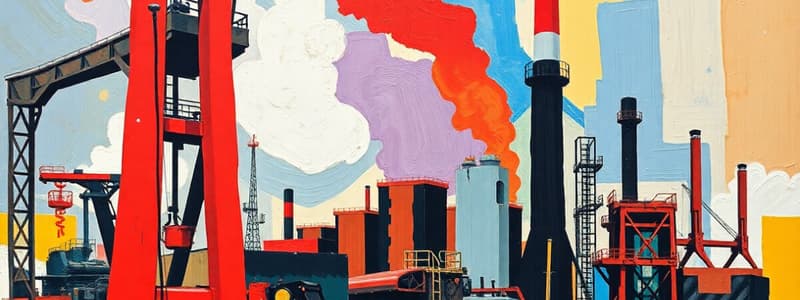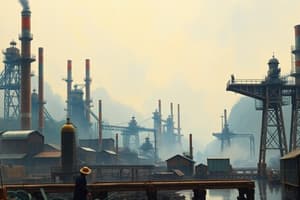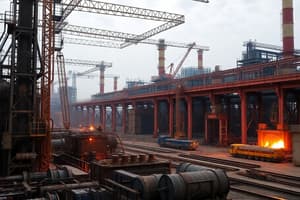Podcast
Questions and Answers
Which raw material was abundant in Benxi?
Which raw material was abundant in Benxi?
- Coal (correct)
- Limestone
- Sand
- Iron ore
The northeast region of China had a difficult terrain for setting up steel plants.
The northeast region of China had a difficult terrain for setting up steel plants.
False (B)
What is one primary factor that contributed to the northeast becoming a steel production hub in China?
What is one primary factor that contributed to the northeast becoming a steel production hub in China?
Access to raw materials and power resources.
The _____ River's floodplain provided ideal land for steel production factories in the northeast.
The _____ River's floodplain provided ideal land for steel production factories in the northeast.
Match the aspects influencing steel production to their descriptions:
Match the aspects influencing steel production to their descriptions:
Which of the following locations was NOT mentioned as a significant source for raw materials?
Which of the following locations was NOT mentioned as a significant source for raw materials?
The iron and steel industry in northeast China experienced difficulties in locating close to markets.
The iron and steel industry in northeast China experienced difficulties in locating close to markets.
What was a key feature of the northeast that made it suitable for the iron and steel industry?
What was a key feature of the northeast that made it suitable for the iron and steel industry?
What type of land was essential for future growth of the steel factories in the northeast?
What type of land was essential for future growth of the steel factories in the northeast?
The steel industry requires large amounts of _____ and iron ore to produce steel.
The steel industry requires large amounts of _____ and iron ore to produce steel.
The northeast was primarily chosen for its location based on luck rather than strategic planning.
The northeast was primarily chosen for its location based on luck rather than strategic planning.
Why was it important for steel plants to be located near raw materials?
Why was it important for steel plants to be located near raw materials?
List one advantage of having a strong local market for the steel industry in the northeast.
List one advantage of having a strong local market for the steel industry in the northeast.
The northeast had large factories due to its _______ land.
The northeast had large factories due to its _______ land.
Which raw materials were easily transported to factories in the northeast?
Which raw materials were easily transported to factories in the northeast?
Transportation in the northeast was described as inefficient and slow.
Transportation in the northeast was described as inefficient and slow.
What role did raw materials and energy play in the northeastern steel industry?
What role did raw materials and energy play in the northeastern steel industry?
The combination of resources, land, markets, and _______ made the northeast a hub for steel production.
The combination of resources, land, markets, and _______ made the northeast a hub for steel production.
Match the following elements with their significance for the northeast's steel industry:
Match the following elements with their significance for the northeast's steel industry:
What was the primary reason the northeast became the heart of steel production in China?
What was the primary reason the northeast became the heart of steel production in China?
Flashcards
China's pre-1950s steel industry location
China's pre-1950s steel industry location
The iron and steel industry was concentrated in Northeast China, particularly in places like Anshan.
Raw material access for steel production
Raw material access for steel production
Locating steel mills near coal and iron ore deposits minimized transportation costs.
Northeast China's flat land
Northeast China's flat land
The northeast region's flat land, especially along the Liao River, facilitated large-scale steel plant construction and expansion.
Steel industry's local market
Steel industry's local market
Signup and view all the flashcards
Abundant Coal in Benxi
Abundant Coal in Benxi
Signup and view all the flashcards
Iron Ore in Fuxin
Iron Ore in Fuxin
Signup and view all the flashcards
Efficient Transportation for Steel
Efficient Transportation for Steel
Signup and view all the flashcards
Liao River Floodplain
Liao River Floodplain
Signup and view all the flashcards
Major Hub for Heavy Industries
Major Hub for Heavy Industries
Signup and view all the flashcards
Location factors in steel industry
Location factors in steel industry
Signup and view all the flashcards
Northeast China's steel industry location
Northeast China's steel industry location
Signup and view all the flashcards
Raw materials & energy in northeast China
Raw materials & energy in northeast China
Signup and view all the flashcards
Flat land in northeast China
Flat land in northeast China
Signup and view all the flashcards
Railway network in northeast China
Railway network in northeast China
Signup and view all the flashcards
Pre-1950s steel industry
Pre-1950s steel industry
Signup and view all the flashcards
Efficient transportation system
Efficient transportation system
Signup and view all the flashcards
Local market for steel
Local market for steel
Signup and view all the flashcards
Optimal industrial location
Optimal industrial location
Signup and view all the flashcards
Key factor for industrial success
Key factor for industrial success
Signup and view all the flashcards
Steel hub
Steel hub
Signup and view all the flashcards
Study Notes
Iron and Steel Industry in China Before 1950s
- Northeast China had a specific distribution pattern for iron and steel industry, notably Anshan.
- Favorable location factors attracted the industry to the region.
Factors for Success
- Raw Materials & Power: Steel requires coal and iron ore, which were abundant in the northeast (e.g., Benxi coal and Fuxin iron ore). This proximity reduced transportation costs.
- Land Attributes: The region's flat land in the Liao River floodplain made large-scale manufacturing possible, accommodating expansion.
- Market Access: The northeast was a hub for heavy industries (e.g., shipbuilding), creating a ready market for steel products. This reduced the need to transport steel to distant locations.
- Transport Infrastructure: Well-developed railway networks facilitated efficient transport of raw materials, energy, and finished steel products. This facilitated the movement of resources and products. This strong infrastructure is a key success factor for the industry.
Studying That Suits You
Use AI to generate personalized quizzes and flashcards to suit your learning preferences.
Related Documents
Description
Explore the development of the iron and steel industry in Northeast China prior to the 1950s. This quiz examines key factors such as raw materials, land attributes, market access, and transport infrastructure that contributed to the industry's success in the region.




